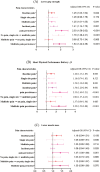Pain Characteristics and Progression to Sarcopenia in Chinese Middle-Aged and Older Adults: A 4-Year Longitudinal Study
- PMID: 38469680
- PMCID: PMC11005774
- DOI: 10.1093/gerona/glae080
Pain Characteristics and Progression to Sarcopenia in Chinese Middle-Aged and Older Adults: A 4-Year Longitudinal Study
Abstract
Background: It is imperative for public health to identify the factors that contribute to the progression of sarcopenia among middle-aged and older adults. Our study aimed to investigate the association between pain characteristics and the progression to sarcopenia and its subcomponents among middle-aged and older adults in China.
Methods: We included 5 568 participants from the China Health and Retirement Longitudinal Study. All participants completed assessments for pain characteristics and sarcopenia. Pain assessment included pain status (baseline pain, incident pain, and pain persistence) and pain distribution (single-site pain and multisite pain) using a self-report questionnaire. Diagnosis of sarcopenia followed The Asian Working Group for Sarcopenia 2019 consensus. The odds ratios (ORs) and 95% confidence intervals (CIs) were obtained by logical regression analysis.
Results: Participants who reported baseline pain, multisite pain, pain persistence, or multisite pain persistence were more likely to progress to sarcopenia than those without pain, with ORs of 1.33 (95% CI: 1.08-1.65), 1.44 (95% CI: 1.15-1.80), 1.63 (95% CI: 1.23-2.14), and 1.59 (95% CI: 1.19-2.11), respectively. Even after adjusting for other covariates such as gender, age, residential area, education level, marital status, smoking, alcohol consumption, comorbidities, and falls, these associations remained significant. Additionally, pain persistence and multisite pain persistence were significantly associated with low grip strength and clinically meaningful Short Physical Performance Battery decline, but not with low muscle mass.
Conclusions: Our study showed that pain, especially pain persistence, was closely correlated to the increased risk of progression to sarcopenia in Chinese middle-aged and older adults.
Keywords: CHARLS; Pain characteristics; Sarcopenia.
© The Author(s) 2024. Published by Oxford University Press on behalf of The Gerontological Society of America.
Conflict of interest statement
None.
Figures


Similar articles
-
Association between sarcopenia and components of metabolic syndrome among Chinese older adults: a population-based longitudinal study using CHARLS.BMC Public Health. 2025 Aug 18;25(1):2823. doi: 10.1186/s12889-025-24090-4. BMC Public Health. 2025. PMID: 40826457 Free PMC article.
-
Insights Into the Association Between Stroke and Sarcopenia Risk in Adults Aged ≥ 50 Years: Cross-Sectional Evidence From Two Large Population Longitudinal Cohorts.Brain Behav. 2025 Aug;15(8):e70763. doi: 10.1002/brb3.70763. Brain Behav. 2025. PMID: 40791098 Free PMC article.
-
Sarcopenia and Risk of Cognitive Impairment: Cohort Study and Mendelian Randomization Analysis.JMIR Aging. 2025 Jun 11;8:e66031. doi: 10.2196/66031. JMIR Aging. 2025. PMID: 40499039 Free PMC article.
-
Prevalence and odds of anxiety and depression in cutaneous malignant melanoma: a proportional meta-analysis and regression.Br J Dermatol. 2024 Jun 20;191(1):24-35. doi: 10.1093/bjd/ljae011. Br J Dermatol. 2024. PMID: 38197404
-
Pharmacological and electronic cigarette interventions for smoking cessation in adults: component network meta-analyses.Cochrane Database Syst Rev. 2023 Sep 12;9(9):CD015226. doi: 10.1002/14651858.CD015226.pub2. Cochrane Database Syst Rev. 2023. PMID: 37696529 Free PMC article.
Cited by
-
Joint association of sleep duration and depression with new-onset hearing loss: a national cohort study.Front Nutr. 2025 Mar 14;12:1528567. doi: 10.3389/fnut.2025.1528567. eCollection 2025. Front Nutr. 2025. PMID: 40161301 Free PMC article.
-
Effects of Malnutrition on the Incidence and Worsening of Frailty in Community-Dwelling Older Adults with Pain.Nutrients. 2025 Apr 22;17(9):1400. doi: 10.3390/nu17091400. Nutrients. 2025. PMID: 40362709 Free PMC article.
-
Joint Association of Remnant Cholesterol and Body Mass Index with Hypertension: A National Cohort Study in Chinese Adults.J Multidiscip Healthc. 2025 Mar 30;18:1813-1825. doi: 10.2147/JMDH.S516335. eCollection 2025. J Multidiscip Healthc. 2025. PMID: 40182616 Free PMC article.
-
Joint association of estimated glucose disposal rate and body mass index with new-onset stroke.Front Neurol. 2025 May 9;16:1529752. doi: 10.3389/fneur.2025.1529752. eCollection 2025. Front Neurol. 2025. PMID: 40417114 Free PMC article.
-
Association Between the Serum Creatinine to Cystatin C Ratio and Cardiovascular Disease in Middle-Aged and Older Adults in China: A Nationwide Cohort Study.J Am Heart Assoc. 2025 May 6;14(9):e040050. doi: 10.1161/JAHA.124.040050. Epub 2025 Apr 25. J Am Heart Assoc. 2025. PMID: 40281656 Free PMC article.
References
-
- Cruz-Jentoft AJ, Bahat G, Bauer J, et al. ; Writing Group for the European Working Group on Sarcopenia in Older People 2 (EWGSOP2), and the Extended Group for EWGSOP2. Sarcopenia: revised European consensus on definition and diagnosis. Age Ageing. 2019;48(1):16–31. 10.1093/ageing/afy169 - DOI - PMC - PubMed
-
- Veronese N, Demurtas J, Soysal P, et al. ; Special Interest Groups in Systematic Reviews and Meta-analyses for healthy ageing Sarcopenia and Frailty and resilience in older persons of the European Geriatric Medicine Society (EuGMS). Sarcopenia and health-related outcomes: an umbrella review of observational studies. Eur Geriatr Med. 2019;10(6):853–862. 10.1007/s41999-019-00233-w - DOI - PubMed

